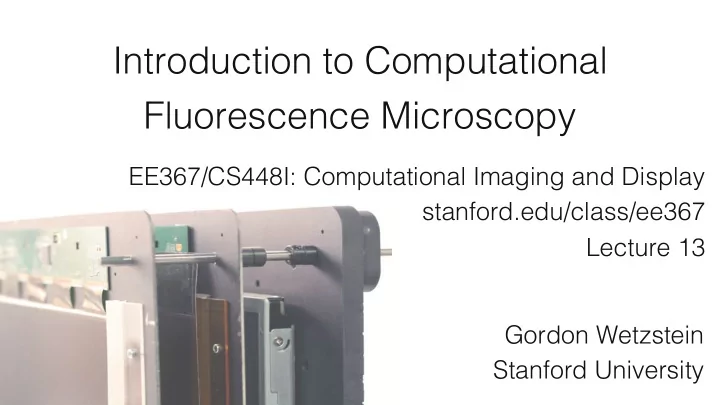

Introduction to Computational Fluorescence Microscopy EE367/CS448I: Computational Imaging and Display stanford.edu/class/ee367 Lecture 13 Gordon Wetzstein Stanford University
Midterm • Wednesday, Feb 26, 3-4:20 pm in Thornt 102 • In In-class ss – yo you need to be here! • open book: use slides, internet, bring computer, whatever you like • can all be solved without programming, similar to theoretical questions of the assignments • only SCPD students can do remotely, we will be emailing you
H. Rankin, transgenic xenopus laevis (african clawed toad) tadpole neurons (green); technique: confocal 10x
M. Kandasamy, stained cells: actin (pink), DNA (yellow), mitochondria (green); technique: super resolution microscopy
M. Boyle, larva of nephasoma pellucidum (peanut worm); technique: confocal 40X
D. Burnette, osteosarcoma cell (bone cancer) showing actin (purple), mitochondria (yellow), DNA (blue); technique: structured illumination microscopy (SIM)
T. Deerinck, HeLa cells with microtubules; technique: 2-photon microscopy 300X
Nikon Small World Competition • annual photography competition, see www.microscopyu.com/smallworld/gallery/ • showed only fluorescent samples (many others in the gallery) • this lecture: overview of fluorescence microscopy techniques
source: white house & nature
Brain Initiative • frontier of science (past frontiers: fly to moon, decode human genome) • two key factors: fluorescence microscopy & computational illumination
Deisseroth Lab, Stanford; CLARITY; Nature 2013
Widefield Microscopy source: microscopyu
Microscope Objective source: Zeiss
The Diffraction Limit Ernst Abbe, 1905 source: wikipedia
The Diffraction Limit λ λ d = 2 n sin α = 2 NA α
The Diffraction Limit λ λ d = 2 n sin α = 2 NA λ α
The Diffraction Limit λ λ d = 2 n sin α = 2 NA λ α Airy disk
The Diffraction Limit λ λ d = 2 n sin α = 2 NA Rayleigh Criterion Airy disk source: wikipedia
Lateral and Axial Resolution & Missing Cone
Fluorescence Microscopy • excitation and emission • coherence / incoherence • fluorescent labels • calcium imaging
Fluorescence Microscopy (epi setup) source: wikipedia
Fluorescence Microscopy (epi setup) source: Nikon MicroscopyU source: wikipedia
Sensors used in Microscopy • e.g., Andor iXon Ultra 897: cooled to -100 ° C or Hamamatsu Ocra Flash4.0 V2 • scientific CMOS & CCD (~20-50K) • reduce pretty much all noise, except for photon or shot noise
Fluorescence Microscopy - Challenges • inherently 2D – need 3D for active brain imaging • higher-resolution in 2D and 3D • scattering • larger fields of view, bleaching • solution: engineer detection and illumination optics, algorithms, chemistry
Fluorescence Microscopy - Challenges • inherently 2D – need 3D for active brain imaging • higher-resolution in 2D and 3D • scattering • larger fields of view, bleaching • solution: engineer detection and illumination optics, algorithms, chemistry
Superresolution Fluorescence Microscopy • stimulated emission-depletion (STED) microscopy • localization microscopy • 2D: STORM/PALM etc. • 3D: double helix PSF • localization algorithms • structured illumination microscopy (SIM)
2014 Nobel Price in Chemistry: super-resolved fluorescence microscopy Stefan Hell W. E. Moerner Eric Betzig (Max Planck Institute) (Stanford) (Howard Hughes Institute)
Stimulated Emission-Depletion (STED) Microscopy excitation spot de-excitation spot emitted spot source: wikipedia
Stimulated Emission-Depletion (STED) Microscopy
Localization Microscopy: PALM / STORM
Structured Illumination Microscopy (SIM)
3D Fluorescence Microscopy • confocal microscopy • 2 photon microscopy • light sheet microscopy • 3D deconvolution microscopy / focal stacks • others: spinning disk confocal, aperture correlation, …
Confocal Microscopy 1957
Confocal Microscopy
Widefield vs Confocal – Thin Sample source: http://microscopysolutions.ca/
Widefield vs Confocal – Thick Sample source: http://microscopysolutions.ca/
2-Photon Microscopy Denk et al. “Two-photon laser scanning fluorescence microscopy”, Science 1990; photo: microscopy.berkeley.edu
2-Photon Microscopy deep imaging good scattering properties Denk et al. “Two-photon laser scanning fluorescence microscopy”, Science 1990; photo: microscopy.berkeley.edu
3D Deconvolution Microscopy
3D Deconvolution Microscopy … whiteboard …
Light Sheet Microscopy • invented by R. Zsigmondy, Nobel price in 1925 • Nature Method of the Year 2014 Huisken et al. “Selective Plane Illumination Techniques in developmental biology”, Development 2009
Ahrens et al. “Whole-brain functional imaging at cellular resolution using light-sheet microscopy”, Nature Methods 2013
Light Field Microscopy • can do refocus, but more interesting: instantaneous 3D volume (for fluorescence)! • diffraction becomes an issue [Levoy et al. 2006]
Light Field Microscopy Levoy Group, Stanford
Levoy Group, Stanford
Light Field Microscopy Levoy Group, Stanford
3D Light Field Deconvolution • light field contains aliasing • use 3D deconvolution to get higher resolution [Broxton et al. 2013]
3D Light Field Deconvolution • lateral resolution is depth dependent! [Broxton et al. 2013]
Functional 3D Brain Imaging C. elegans [Prevedel et al. 2014]
Functional 3D Brain Imaging Captured Light Field optics design by Marc Levoy [Prevedel et al. 2014]
maximum intensity projection of volume 350um x 350 um x 24 um at 50Hz ~70 neurons in head region [Prevedel et al. 2014]
[Prevedel et al. 2014]
Recommend
More recommend